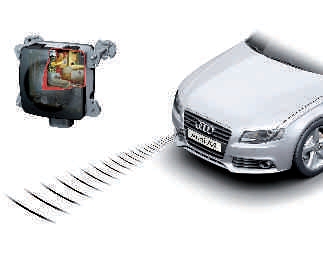Safety based on radar technology – Audi braking guard
The amount of traffic on our roads is increasing constantly, as is the amount of information that needs to be processed – meaning that the task of driving is becoming ever more demanding. Audi has developed a technology which promises more relaxed, safer motoring: the Audi braking guard brake assist system is designed to reduce the risk of rear-end collisions. It is one of a whole generation of intelligent assistance systems which monitor the area surrounding the car in order to offer additional protection. Audi braking guard is available for the A4, A4 Avant, A6, A8 and Audi Q7 model lines, as well as for the new Q5.
Audi braking guard forms part of the radar-based adaptive cruise control system, or ACC for short. This system regulates the speed and the distance from the vehicle in front at speeds between 30 and 200 km/h, independently applying the brakes within certain limits in the process.
The computer is integrated into the vehicle data bus network and is able to communicate with the control units for the engine, automatic transmission and brakes – all within a few thousandths of a second! The entire expertise that Audi has amassed in this field is behind the software's architecture and detailed design.

ACC allows the driver to choose between various drive modes. These modes define the minimum time interval to the vehicle ahead in four increments (between 1.0 and 2.3 seconds), as well as altering the dynamic characteristics of the regulation process in three stages, from comfortable through to sporty. The system adjusts speed and distance by accelerating or braking, while giving priority to comfort. The rate of deceleration is limited to a maximum of 3 m/s2 above 50 km/h. This is barely a third of the potential braking power and has the same effect as pressing the brake pedal with moderate force.
If the vehicle in front brakes abruptly, however, a situation can arise in which this automatic braking function may no longer be enough. What is more, the driver may not perceive the new situation fast enough; analyses of Audi accident research show that 70 percent of all collisions are caused by drivers who are distracted, tired or not concentrating. This is where the ACC subsystem Audi braking guard comes into action, warning the driver in two separate stages.
Stage one consists of a warning gong and a red symbol that flashes up in the instrument cluster. The ESP stabilization system makes sure that the brake system is primed with hydraulic fluid. If the driver still fails to take action, this is followed by the second stage known as the "acute" warning. This stage is triggered when the warning algorithm comes to the conclusion that the situation can only be mitigated if the driver reacts immediately – usually by executing an emergency braking.
The form of the acute warning was a key issue during development of the system. During an extensive series of tests carried out with subjects from the University of the Federal Armed Forces in Munich, the engineers were able to test out various possibilities. The clear winner was the warning jolt, which is generated by a swift build-up of pressure in the braking system and lasts just 0.5 seconds. This slows down the vehicle by no more than 5 km/h to avoid any risk of being shunted by following traffic.
In the vast majority of the cases observed during testing, the warning jolt caused distracted drivers to return their attention to the road ahead and step on the brakes. With the aid of the hydraulic brake assist system, Audi braking guard instantly converts the driver's action into an emergency stop without any delay. By priming the brake system, the ESP system saves between 100 and 200 milliseconds – which can equate to a distance of over seven meters (approx. 23 feet) at 130 km/h (approx. 80 mph).

Audi braking guard is also on the lookout when the ACC system is deactivated. On the other hand, the advance warning and the entire braking guard feature can also be switched off separately, in keeping with the Audi philosophy of giving drivers as much control as they want. At Audi, the focus is never on technology as an end in itself – our technology always revolves around people.
Other important assistance systems from Audi include Audi side assist, Audi lane assist and the Audi parking system advanced. Audi side assist uses radar beams to monitor the area rearwards of the car and to the sides. Lamps in the exterior mirrors warn the driver not to change lanes if there is another vehicle in the blind spot or approaching fast from the rear. Audi lane assist recognizes the lane perimeter markings by means of a small camera behind the windscreen – vibrations in the steering wheel alert the driver when the vehicle comes too close to the markings. The Audi parking system advanced is a luxury parking aid which projects the image from a rear-view camera onto the in-vehicle monitor, as well as superimposing helpful guide lines.
Audi Technology ABC
The radar system from Audi is pure high-tech. The radar sensor is positioned in the front end of the car on the right next to the single-frame grille, and incorporates four transceiver units behind a plastic lens into its housing. These units send out waves at a frequency of 76.5 gigahertz in 100 millisecond intervals. The measurement scans a field 180 meters in length with a beam angle of eight degrees.
The computer analyses the differences between successive measurements. Using the Doppler effect and the signal traveling time, the computer can determine the distance to the vehicle ahead, as well as whether the distance is changing and at what rate. By comparing the signals from the four individual antennae, it can also ascertain the angle of the vehicle ahead in relation to the car's own direction of travel. This in turn is calculated from radar information on lane boundary markers, such as crash barriers, as well as from various signals provided by the ESP stabilization program.










